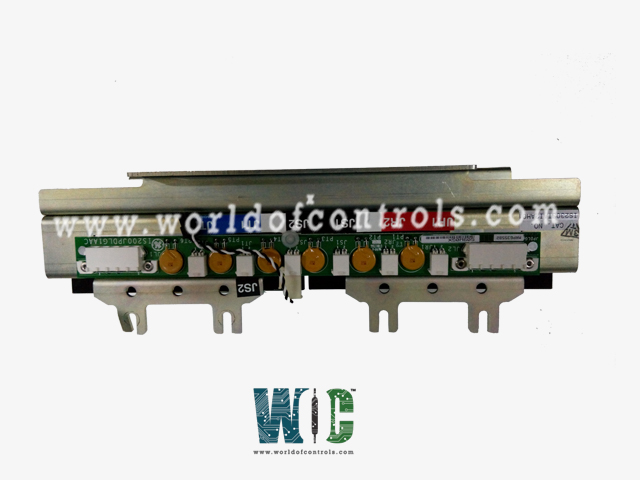SPECIFICATIONS
Part No.: IS230STTCH4A
Manufacturer: General Electric
Product Type: Thermocouple Input Module
Number of channels: 12
Thermocouple types: E, J, K, S, T thermocouples, and mV inputs
Span: -8 mV to +45 mV
Technology: Surface-mount
Availability: In Stock
Country of Manufacture: United States (USA)
Series: Mark VIe
Functional Description
IS230STTCH4A is a Thermocouple Input Module developed by GE. It is a part of Mark VIe control system. The terminal board is a highly efficient and space-saving solution, carefully engineered for easy installation on DIN-rails or flat surfaces. Its primary purpose is to facilitate the connection of 12 thermocouples to either the PTCC thermocouple processor board on the Mark VIe or the VTCC thermocouple processor board on the Mark VI, two cutting-edge systems known for their precision and reliability.
Product Attributes
- Supports 12 Thermocouple Inputs: Allows connection of up to 12 thermocouples, enabling multi-point temperature monitoring from a compact module. Ideal for turbine casing, exhaust, or bearing temperature measurement.
- Signal Conditioning and Cold Junction Reference: Integrates on-board signal conditioning circuitry to amplify and filter raw thermocouple signals. Includes a cold junction reference sensor to compensate for ambient terminal temperature, ensuring precise temperature readings.
Features and Capabilities
- Mounting Flexibility: Supports installation on DIN rails or flat panel surfaces. Compact design minimizes panel footprint in control cabinets.
- High-Density Termination: Equipped with Euro-block terminal blocks (two types available) for secure and organized wiring. Designed for durability and ease of wire insertion/removal.
- On-board Cold Junction Compensation (CJC): Measures temperature at a precisely selected cold junction location on the terminal board. Ensures accurate temperature differentials are calculated between thermocouple tip and junction. Cold junction accuracy: 17°C, suitable for turbine control tolerances.
- Hardware-level Limit Checks: Implements high and low temperature threshold checks at the hardware layer. Enables early fault detection and alarm triggering in the event of abnormal thermal behavior.
- On-board ID Chip (JA1 Connector): The board includes an identification (ID) chip on the JA1 connector. Used by the processor (PTCC or VTCC) to confirm correct board presence and type. Supports system-level diagnostics and compatibility verification, preventing misconfiguration or installation errors.
Integration Notes
- It does not perform temperature conversion or linearization directly. These tasks are handled by the connected thermocouple processor board (PTCC/VTCC).
- It is intended for use with standard thermocouple types supported by GE's turbine control systems (e.g., Type K, J, E, T, etc.).
- The signal routing is differential to minimize noise pickup over long cable runs in high-EMI environments.
Installation Guidelines
- Along with a plastic insulator, is ingeniously designed to be mounted on a sturdy sheet metal carrier, which itself can be easily attached to a DIN rail. This smart mounting arrangement ensures a secure and efficient installation process, allowing for hassle-free integration into various systems and setups.
- Furthermore, the flexibility of the board is evident as it can also be mounted directly onto a sheet metal assembly, which is then conveniently bolted into a panel. This alternative mounting option provides additional versatility, enabling the terminal board to be seamlessly incorporated into control panels or other equipment where space might be a concern.
- When it comes to wiring, the module offers straightforward connectivity for thermocouples. The thermocouples are directly wired to the terminal block using typical #18 AWG wires, making it easy to establish reliable connections without the need for complex wiring schemes.
- The Euro-Block type terminal block on the board is a standout feature, boasting an impressive array of 42 terminals. These terminals can be customized to suit specific requirements, offering a combination of fixed or removable options. This adaptability allows for easy maintenance, modifications, or expansions of the thermocouple system, as needed.
World of Controls has the most comprehensive collection of GE Mark VIe components. Please contact WOC as soon as possible if you require any extra information.
Frequently Asked Questions
What is IS230STTCH4A?
It is a Thermocouple Input Module developed by GE
What is the purpose of the I/O pack or board when connecting board?
The I/O pack or board contains the analog-to-digital converter (A/D converter) and serves as the interface between board and the central processing unit. It facilitates the conversion of analog signals from the thermocouples and the cold junction reference into digital data that can be processed and utilized by the control system.
How is the cold junction reference (CJ) on the terminal board powered and controlled?
The I/O pack or board is responsible for providing excitation to the cold junction reference (CJ) on the STTC. It supplies the necessary power to maintain a stable temperature at the cold junction, ensuring accurate compensation for the thermocouple readings.
What signals are transmitted through connector JA1 between the terminal board and the I/O pack or board?
Connector JA1 is a critical interface between the terminal board and the I/O pack or board. It allows the transmission of the 12 thermocouple signals from the terminal board, along with the cold junction (CJ) signal, which is used for cold junction compensation. Additionally, the connection to the identity chip (ID) is established through this connector for system recognition and diagnostic purposes.
